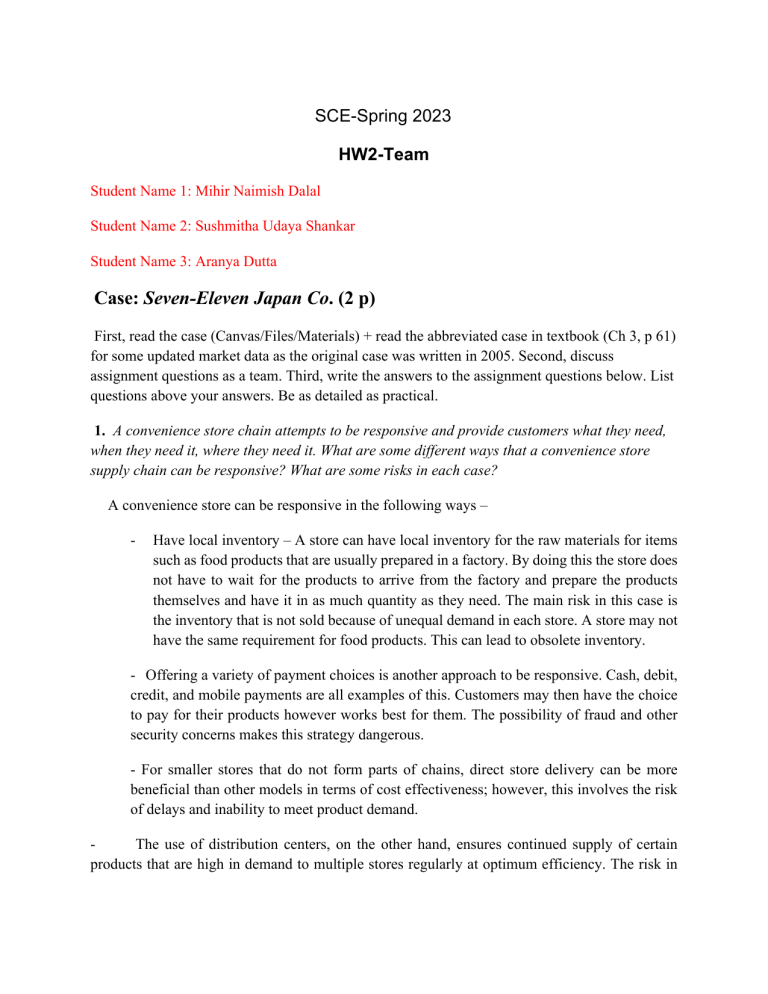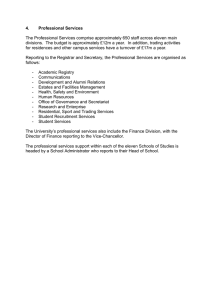
SCE-Spring 2023 HW2-Team Student Name 1: Mihir Naimish Dalal Student Name 2: Sushmitha Udaya Shankar Student Name 3: Aranya Dutta Case: Seven-Eleven Japan Co. (2 p) First, read the case (Canvas/Files/Materials) + read the abbreviated case in textbook (Ch 3, p 61) for some updated market data as the original case was written in 2005. Second, discuss assignment questions as a team. Third, write the answers to the assignment questions below. List questions above your answers. Be as detailed as practical. 1. A convenience store chain attempts to be responsive and provide customers what they need, when they need it, where they need it. What are some different ways that a convenience store supply chain can be responsive? What are some risks in each case? A convenience store can be responsive in the following ways – - Have local inventory – A store can have local inventory for the raw materials for items such as food products that are usually prepared in a factory. By doing this the store does not have to wait for the products to arrive from the factory and prepare the products themselves and have it in as much quantity as they need. The main risk in this case is the inventory that is not sold because of unequal demand in each store. A store may not have the same requirement for food products. This can lead to obsolete inventory. - Offering a variety of payment choices is another approach to be responsive. Cash, debit, credit, and mobile payments are all examples of this. Customers may then have the choice to pay for their products however works best for them. The possibility of fraud and other security concerns makes this strategy dangerous. - For smaller stores that do not form parts of chains, direct store delivery can be more beneficial than other models in terms of cost effectiveness; however, this involves the risk of delays and inability to meet product demand. The use of distribution centers, on the other hand, ensures continued supply of certain products that are high in demand to multiple stores regularly at optimum efficiency. The risk in such an arrangement is the challenge to rid distribution centers of inventory in case there is a change in product demand. - And finally, another method to be responsive is to take a customer-centric perspective. This may entail offering warm customer service, providing rewards and discounts for loyalty, and customizing goods and services to suit client requirements. This strategy, nevertheless, carries a certain amount of risk because it necessitates the shop making costly investments in loyalty programs and customer service staff, if only a small number of consumers sign up for the staff and loyalty program services 2. Seven-Eleven’s supply chain strategy in Japan can be described as attempting to micromatch supply and demand using rapid replenishment. What are some risks associated with this choice? The strategy of micro-matching supply and demand using rapid replenishment assumes that the product demand pattern in a particular store is uniform and does not vary much regularly. Any change in the demand pattern can potentially cause the stock of products in a store to run out quickly and lead to a bottleneck. That, in turn, can lead to delays in transportation and, in turn, an increase in transportation costs associated with the replenishment method. Seven-Eleven’s supply chain is also heavily dependent on its integrated store information system that makes use of equipment like computers, graphic order terminals, scanner terminals and point-of-sales registers interacting with each other. A lapse at any point in the information system can put the entire supply chain out of order. Another danger is that Seven-Eleven might be unable to estimate client demand effectively. Seven-Eleven may end up with surplus inventory that cannot be sold or a lack of inventory if they misjudge client demand and order an excessive amount of a specific item. As a result, inventory may need to be discounted in order to move or be kept in warehouse 3. What has Seven-Eleven done in its choice of facility location, inventory management, transportation, and information infrastructure to develop capabilities that support its supply chain strategy in Japan? Facility Location – The method chosen by Seven Eleven in its facility location planning is by having around 50 to 60 stores in a particular region and it was supported by a distribution center it mainly focuses on providing convenience to the customers Their facility locations are selected with reference to the principle of market dominance, meaning these locations have a high population of potential consumers, along with robust transportation systems to make the locations as accessible as possible. More new stores are set up in those areas where there is a cluster of already existing Seven-Eleven stores to guarantee the effective distribution and rapid provision of products. Inventory Management – Seven Eleven used to manage the inventory according to the demand of the specific products. They put forth a system called just in time here it keeps track of the inventory levels and adjust the stocks accordingly due to which there was an improvement in availability of goods. They also made use of a computerized system that tracks the sales and lists of stores through which they were able to understand the behavior of the customers and what they exactly need and then change their list according to the needs whenever required. Transportation – Seven Eleven managed transportation by transporting all the material from the supplier to a distribution center where all the products were combined according to the region and product type and then they were shipped from the distribution center to the convenience store. They had different temperature-controlled trucks for different kinds of products Seven-Eleven also decreases the number of used delivery vehicles from 70 to a meager 11 over a span of 20 years, without any adverse effects on business because of how its manufacturers, distribution centers and suppliers communicate with each other through the implementation of efficient transportation systems and the Total Information System. Information Infrastructure – Seven Eleven used a Total Information System and installed it in every outlet which was connected to the headquarters, the stores and the distribution centers. The company has made use of different hardware system to track and monitor levels which helps to reduce cost some of the systems used are as follows Graphic Order Terminals – This was used to place orders. Scanner Terminals – This was used to read barcodes and record inventory. Incoming products were scanned and reconciled against the outgoing products. Store Computers – This was used to connect every piece of software and POS registers. 4. Seven Eleven does not allow direct store delivery in Japan with all products flowing through its distribution center. What benefit does Seven Eleven derive from this policy? When is direct store delivery more appropriate? - - The benefit that Seven Eleven gains from its policy of delivering everything via a distribution center is that when the products flow from the supplier to the distribution center, products can be combined according to the region and be loaded into the trucks that are assigned to a particular region. In the case of Seven Eleven the products were divided into three categories – frozen food, chilled foods, and room temperaturecontrolled foods. Products from different suppliers were combined into a single truck and shipped accordingly. By having this type of distribution system, the number of vehicles that visited a particular store was reduced from 70 to 11 due to which the cost was also reduced. Direct store delivery is more appropriate when a particular product constitutes most of the stores’ sales. For example, if the entire chain of stores receives a product from only one supplier, then it would make more sense for the supplier to ship the product directly to the store rather than having to ship it to a DC and then from DC to a store. This would increase costs. Direct store delivery can also be selected when a store needs certain products to be provided only a few times a week. In this case, it is almost impossible to address the problem of delays and increasing demands. 5. Top Three things you learned from this case? ❖ Expansion Policy – The store expansion policy of Seven Eleven allowed them to exploit a particular market rather than focusing on expanding the franchise to the entire country. Whenever they entered a market, they made a cluster of 50 – 60 stores which was supported by a Distribution Center. This allowed them to have a high market presence and allowed efficient operations. This ensured companies growth by allocating resources to their most profitable customers. ❖ Different methods to attract customers other than sales – Seven Eleven did not attract customers just through store sales. They tried different methods which increased their customer base. Firstly, they introduced in store bill payments of Tokyo Electric Power bills. They then expanded to other payment methods. They later introduced 7dream.com, which was an ecommerce company. They understood the customers and made stores as drop off points where customers could pick up their orders. The importance of understanding the customer’s needs and getting to know their behavior so they can provide necessary quality services due to which customers trust the company and revisit the store. ❖ Location and keeping up with current trend- To stand up in the crowd among all the other companies they were up to date with the changing trends and technologies and were ready to adjust to the change is customers’ needs and liking and making sure their product has the same quality in the fast-changing market. Seven Eleven has selected sites where it can quickly construct stores without interfering with neighboring businesses or clogging up local roadways with traffic. Additionally, it has chosen locations that are simple for clients to get using their vehicles, such as cars, motorbikes, scooters, or bicycles, or by public transportation by keeping an open mind to change and responding fast to emerging trends, SEVEN ELEVEN has been able to do this. Any business must make the best possible site choice. It is necessary to adapt the product lineup to the region's diverse geography and culture.


